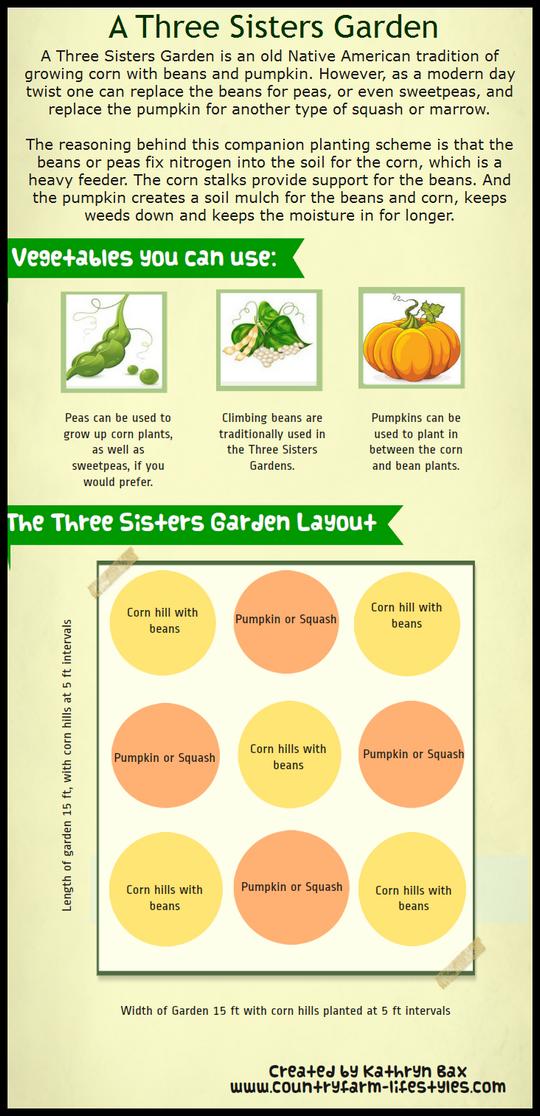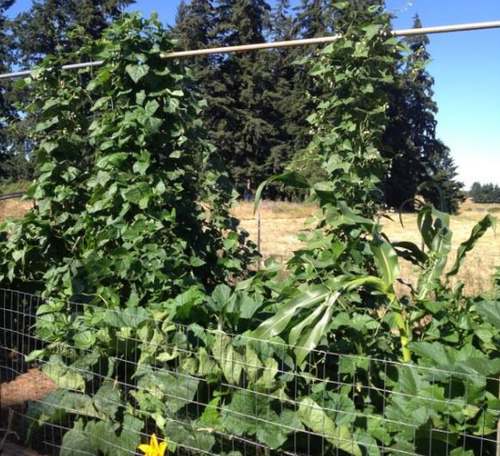A New Twist on the Three Sisters Garden Layout, Planting Methods and History
History of the Three Sisters Garden
It was a Patuxet Indian, called Squanto who taught the Pilgrims of Plymouth how to hunt for their food, tap the maple sap and plant important crops for their survival. It was Squanto who introduced them to the Indian tradition of growing corn, squash and beans together that has today become known as the 3 Sisters Garden.
In permaculture today, we talk about growing things and building things that have several purposes. But as you can see, this is not a new concept. The American Indians were growing peas, beans and cucumbers up corn stalks long before the word permaculture was coined.
It was the Iroquois who first started the system of planting corn, beans and squash together in a system that works exceptionally well together. Each plant grows to benefit the other.
Purpose Behind a Three Sisters Garden
- The beans grow, fixing nitrogen into the soil.
- The squash, with their shallow roots provide shade to the roots and help keep the weeds down. Pumpkins are also one of the few vegetables that do really well in partial shade.
- The corn, benefitting from both the soil mulch and the extra nitrogen, are supports for either the peas or beans if they are the climbing variety.
Three Sisters Garden Layout, Spacing and Method of Growing
Now you need to get your spacing right. Plant out your corn seeds in the hills spaced 5 feet apart, planting 4 seeds per hill. Each hill being 18 inches in diameter.
Now wait until your corn plants are at least 4-6 inches tall before you plant your bean or pea seeds inbetween the corn at the base, on this same hill. This is important, because if you plant all the seeds out at the same time, your corn stalks will not be strong enough to carry the weight of the climbing plants.
Now, you can now plant your pumpkin or squash seeds using the same hill method. Each hill is again 18 inches in diameter and you can plant 4 seeds per hill. The hills are created in between the rows of the corn and beans.
An Infographic on How to Grow a Three Sisters Garden

Best Types of Squash, Corn and Beans for a Three Sisters Garden
Some good corn varieties are:
Golden Bantam, Country Gentleman, Stowell's Evergreen, Bloody Butcher.Bloody Butcher is an excellent tall variety of corn growing 10 - 12 feet high. It is good for corn on the cob, and when mature making flour and corn meal. Although the Golden Bantam is lovely and sweet it only grows to 5 feet, whereas Country Gentleman grows to 7 feet and is excellent for canning and making creamed sweetcorn.
Some good bean varieties are:
The types of beans you need to plant will be the climbing variety. However, you may find that your beans may need additional support if the variety you have used climbs really high, as your corn or sunflowers just won't be tall enough to give them the support that you need.Scarlet Emperor, for example, is a good climbing b eanvariety but too tall for a Three Sister Garden as it grows 8-10 feet tall, unless you are growing them with together with Bloody Butcher corn, which is the one corn variety tall enough to be grown together.
Climbing French beans, runner beans or borlotti beans are all suitable for your three sisters garden.
Tips for Successful Three Sisters Gardens
- Always wait until your corn has grown 4 inches before planting the bean seeds and squash seeds. If not you will end up with a tangle of plants each smothering the other and the corn will be buried under the beans rather than supporting them.
- Make sure that you space the plants correctly, for the same reason. You don't want too much shade, especially for your squash and watermelon.
- Plant squash types that grow horizontally and are not too bushy. Zucchinis are not good for this type of system.
- Plant tall varieties of corn to support the right variety of beans.

A Three Sisters Garden where the corn and beans were planted at the same time. This smothered the corn and the taller beans had to be given additional support.
Three Sister Garden Variations
Of course there are
other vegetables you can plant, using this method. There are three
sister gardens where instead of corn
being used,
sunflowers are grown instead. Both of these plants work well, for
providing the scaffolding for the beans to grow upwards.
And, if you are not fond of pumpkin or squash,
then you could plant
melons or watermelons. Baby sugar melons do well with this method of
growing.
Instead of beans you can grow peas, or even sweetpeas up the corn stalks.
Conclusion:
So grow a slice of living history in your vegetable gardens with your kids by growing a three sister garden of your own.
You can Add your Own Comments and Pages on your Three Sisters Garden Here!
We have lots of pages where you can contribute to throughout this homesteading website. We love hearing from our readers, and hope you will be one of those we hear from too. Look around our homesteading website. If you have any comments or questions, please feel free to contact us.
Leave a Comment
Do you have anything that you would like to add after reading this page? We would love to hear your thoughts. If you can add additional information to what has been written here you will be adding value to the website! No need to have any special skills - just type and submit. We will do the rest!








New! Comments
Do you have something of value to add? Leave me a comment in the box below.